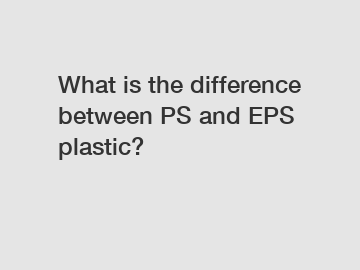Feb. 03, 2024
Agriculture
What is the difference between PS and EPS plastic?
Plastic products are widely used in various industries, and it is important to understand the different types of plastics available. Two commonly used types are PS (polystyrene) and EPS (expanded polystyrene), which have distinct characteristics and applications.
PS plastic, a versatile and lightweight material, is commonly used in the production of disposable food containers, packaging materials, and consumer goods. It is affordable and has excellent insulation properties, making it suitable for hot and cold food storage. However, PS is non-biodegradable and takes hundreds of years to decompose, leading to environmental concerns.

On the other hand, EPS plastic, also known as Styrofoam, is a type of PS plastic that has been expanded with air. This process creates a foam-like material, which is lightweight and offers excellent insulation properties. EPS is commonly used in packaging, construction, and insulation due to its low thermal conductivity. However, like PS, EPS is non-biodegradable and poses environmental challenges.
The main difference between PS and EPS lies in their physical structure and manufacturing process. PS is a solid, while EPS is a foam with air-filled cells. This difference in structure results in contrasting properties and applications for the two materials.
The production of PS involves the polymerization of styrene monomers, which creates a compact and solid plastic material. It can be easily molded into different shapes using injection or extrusion techniques. EPS, on the other hand, is produced by expanding PS beads using steam and pressure. During this process, the beads fuse together, creating a lightweight foam with air-filled voids.
The lightweight and insulating properties of EPS make it an ideal choice for packaging fragile objects, as it provides cushioning and protection. It is also commonly used in the construction industry for thermal insulation and soundproofing purposes. EPS can be easily cut and shaped, making it convenient for various applications.
The non-biodegradable nature of both PS and EPS plastics is a significant concern for the environment. These materials take hundreds of years to decompose and can contribute to pollution and waste. However, research and development efforts are focused on finding sustainable alternatives to these plastics.
In conclusion, PS and EPS plastics have distinct characteristics and applications. PS is a solid plastic used in food containers and consumer goods, while EPS is an expanded foam with excellent insulation properties commonly used in packaging and construction. The difference in their physical structure and manufacturing process accounts for their contrasting properties. However, the non-biodegradability of both plastics highlights the need for sustainable alternatives in the future to mitigate the environmental impact.
Are you interested in learning more about Pre-Expander Machine, What is the difference between lost foam casting and solid casting, What is the EPS machine?? Contact us today to secure an expert consultation!
Previous: Ultimate Guide: Concertina Razor Barbed Tape - Benefits, Installation & Maintenance
Next: What is the American Standard Code for pressure piping?
If you are interested in sending in a Guest Blogger Submission,welcome to write for us!
All Comments ( 0 )